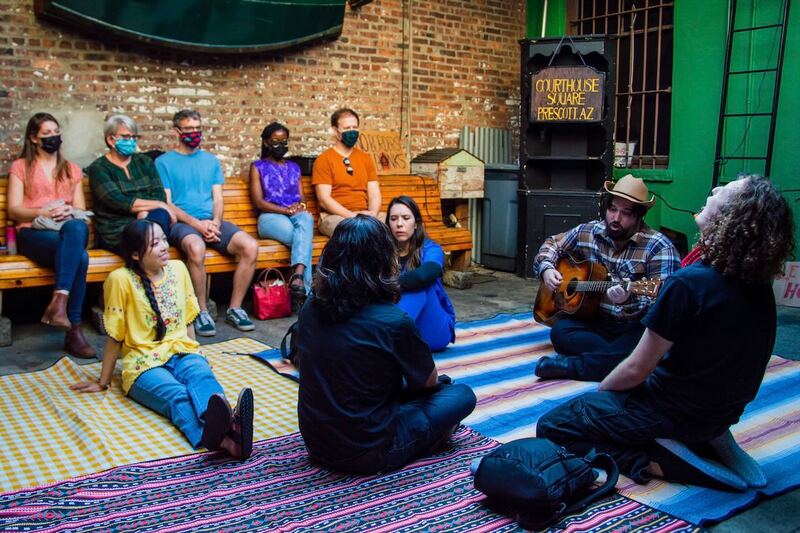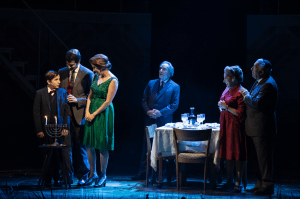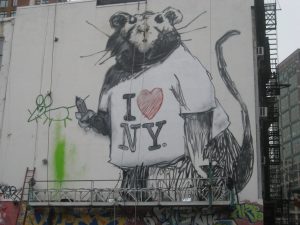‘Occupy Prescott’: A Modern Interpretation of the Occupy Wall Street Movement
Theater in Asylum’s returning production ‘Occupy Prescott’ serves as a modern interpretation of how the 2008 financial crisis affected the way American’s view political solutions differently
COURTESY OF SHUBRA MISHRA
“Occupy Prescott,” Theater in Asylum’s first show since before the pandemic, centers on a small town as it faces the 2008 financial crisis.
November 23, 2021
“Occupy Prescott” premiered on Oct. 16 at the Jalopy Tavern in Brooklyn. The play was presented by Theater in Asylum and was its first in-person production since the beginning of the COVID-19 pandemic. The play presents a reenactment of American working-class calls for a solution to income inequality during the 2008 financial crisis.
The play, directed by Paul Bedard and Katie Palmer, and written by Andy Boyd, interprets the famous Occupy Wall Street Movement within small-town America — specifically, Prescott, Arizona — circa 2011.
The audience is introduced to the five central characters at the beginning of the show. Rex is an economically conservative farmer and a rancher; Connie is a 60-year-old hippie dedicated to her spirituality; Devin is an anarchist; Dolores is a recent divorcee, mother and nurse; and Father Carlos is a Catholic priest and former union organizer.
They are a group with almost nothing in common, so what brings them together?
What ties them together is none other than their contempt for the way the American government has handled the financial crisis.
The Occupy Wall Street Movement — renamed Occupy Prescott, given the town they live in — unites this unlikely group, as well as their distaste for America’s current economic conditions.
The play commences with a scene at the local Courthouse Square in Prescott, with the five characters introducing themselves to each other and asking what brought them into the Occupy Movement.
Although all of their motivations stem from their unique backgrounds and occupations, what ties them together is none other than their contempt for the way the American government has handled the financial crisis. Quite honestly that is the only thing that ties them together. From extreme debt brought on by a divorce to anti-capitalist activism, each character is joining this movement for their own unique reasons and with their own different proposed solutions.
Thus, we quickly see the group hit stagnation, stemming from their inability to successfully construct a manifesto that outlines common beliefs of their movement. In each act, the group sits down to craft a manifesto: They disagree about an issue, a character gets mad, they sort out their disagreements and they learn a valuable lesson and attempt to write again. But, when they sit down another time, they inevitably fail.
These five people are forced into deeply personal discussions where they question each other’s political and religious motivations and are forced to defend their core beliefs in front of one another, all in the name of creating a manifesto that might have the ability to change the world one day — emphasis on the might.
Their struggles prompt one of the most important questions in activism today: What are our movements meant to grow into after they’ve organized themselves? We could think of the Black Lives Matter movement and the vastly different opinions on where the movement should be heading after the initial organization occurred. With some people advocating for police reform, others advocating for defunding the police, and some advocating for total abolition of police and prisons. There was no single lane of thought and it led many Americans to feel frustrated in their personal activism.
And although the structure of the play aimed and successfully replicated this political frustration that Americans feel every day toward the government, counter political beliefs, and social movements, the composition of the performances often felt cyclical and repetitive.
We all think of activism and revolution as ideas that sound bold, beautiful and breathtaking, but real-life change is a tough and gritty process.
One could say that this was a metaphor meant to represent the frustratingly inadequate political system we live in and how that affects our inability to agree on policy, but it often felt alienating toward the audience. There were many times throughout the play where one could sit thinking, “Didn’t they just discuss this issue in the last act?”
However, this play did lead me to think about how contemporary political issues seem just as repetitive as this play did in certain acts. No matter what issue anyone may choose to champion, we feel that the political process is nowhere near linear and that many times as a country, we take two steps backward for every step forward. Boyd successfully represents that frustration through his play, presenting each character’s humanizing experiences and successfully molding them into figures that exist in small-town America.
“Occupy Prescott” is a depiction of the dirty work that has to occur in everyday activism. We all think of activism and revolution as ideas that sound bold, beautiful and breathtaking, but real-life change is a tough and gritty process. In many situations, activism and revolution can be boring and repetitive. But the message that one can take from this play can be a bit more hopeful than that.
“I hope that an audience member feels hopeful at the end (of this play) … a little bit more connected to our roots,” said Katie Palmer, one of the co-directors of the play. “We hope that an audience member realizes that the shape of change is ever-reforming and we need change urgently, but we also need to make sure that everyone is a part of that change.”
















